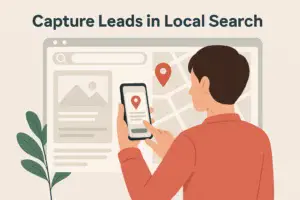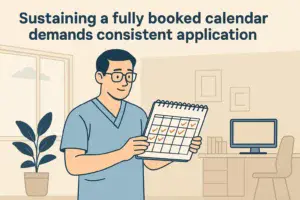
The Silent Revenue Killer: Gaps in Your Appointment Calendar
Empty slots in an elective clinic’s calendar represent more than just missed opportunities—they directly impact the clinic’s bottom line. Consistent gaps reduce revenue potential and can undermine staff morale and operational efficiency. For elective clinics such as plastic surgery centers, weight loss facilities, and med spas, maintaining a steady flow of booked appointments is essential for sustaining growth.
Many clinic owners notice fluctuating demand, but the deeper issue often lies in the appointment booking challenges that prevent sustained occupancy. These gaps result from a combination of marketing inefficiencies and operational hurdles rather than just external market forces.
Reason 1 – Poor Lead Conversion and Follow-Up
Attracting potential patients is only the first step. Research consistently shows that responding quickly and effectively to leads dramatically increases conversion chances. According to a Harvard Business Review study on lead response times, firms that respond within an hour are significantly more likely to convert leads than those that wait longer.
Many clinics fall short here: inquiries come through various channels, but follow-up is inconsistent or slow, resulting in lost opportunities. Whether it’s an unanswered phone call, a delayed email response, or ineffective messaging, poor lead management erects multiple barriers between an interested individual and a confirmed booking.
Implementing a structured follow-up protocol ensures that no leads are overlooked. Clinics that integrate prompt and personalized communication see notable improvements in their clinic conversion rate.

Reason 2 – Weak Online Presence and Unoptimized Website
In an era where patients often search for elective procedures online before making a decision, a clinic’s digital footprint plays a pivotal role. A dated or difficult-to-navigate website repels visitors and contributes to lost bookings. Equally problematic are minimal reviews, a lack of patient education content, and poorly optimized local search presence.
Elective clinic marketing must encompass search engine optimization (SEO) tailored to high-intent local issues. Clinics that fail to appear prominently in local search results miss out on a stream of motivated prospects ready to schedule consultations and treatments.
The website itself should serve as a conversion engine. Clear calls to action, intuitive navigation, and reassurance through testimonials and procedural information create trust and streamline patient acquisition efforts. Neglecting these areas diminishes patient confidence and contributes to persistent calendar gaps.
Reason 3 – Misaligned or Ineffective Offers
Promotions and offers must appeal to patient priorities and motivations. Elective clinics often struggle because their services or package deals are not explained compellingly or fail to meet patient expectations. Sometimes offers feel generic, disconnected from the prospective patient’s journey, or overly complex.
Aligning clinic offers with patient needs improves the likelihood of bookings. For instance, a med spa might introduce a first-time visitor discount targeting specific treatments popular in the area, while plastic surgery practices may bundle consultations with financing options. Clear, relevant offers not only attract leads but also encourage quicker decisions.
Without this alignment, even the best marketing and follow-up strategies may falter. Ineffective offers increase the patient’s hesitation, widening appointment gaps.
The 3-Part Framework to Reverse the Trend
To address these challenges systematically, a three-step framework focuses on capturing, converting, and closing leads effectively. Clinics adopting this framework report sustained growth and improvements in patient acquisition.

Step 1: Capture Leads Through High-Intent Local Search
Patients seeking elective procedures often perform local searches with specific intent, such as “best Botox clinic near me” or “plastic surgeons in [target city].” Targeting these searches enables clinics to attract potential patients who are actively looking to book.
Strategies for maximizing capture include refining local SEO, creating targeted ads with precise geographic and service specifications, and maintaining up-to-date directory listings. Tools that analyze search trends in your region provide insights into service demand and help customize marketing efforts accordingly.
Ensuring your clinic ranks prominently for these terms channels high-quality leads toward your website or contact points. High-intent local leads tend to have stronger purchasing motivation, yielding better clinic conversion rates.
Step 2: Convert with Better Messaging and Website UX
Once potential patients arrive, the clinic’s messaging and user experience (UX) determine whether they stay and take action or bounce away. Effective messaging addresses common concerns, highlights outcomes, and differentiates the practice.
Simplifying website navigation and mobile responsiveness are critical, as many patients browse on their phones. Additionally, placing clear calls to action, such as “Schedule a Free Consultation” or “Chat with a Patient Counselor,” helps lead visitors toward commitment.
Transparent pricing information and evidence-based content about procedures build trust. Patient testimonials and before-and-after galleries also enhance credibility.
Improving these elements enhances engagement and facilitates booking decisions, thereby reducing friction in the patient journey.
Step 3: Close with Automation and Human Touch
Successful clinics strike a balance between efficient automation and personalized communication. Automated systems for appointment reminders, lead tracking, and drip email campaigns maintain contact without overwhelming staff resources.
At the same time, human engagement remains vital. Personalized calls or messages demonstrate responsiveness and care, reassuring patients who may have lingering questions or concerns before making a decision.
Combining these approaches leads to higher close rates. Automation handles routine touchpoints, while human follow-up addresses nuances and builds relationships.
This harmony between technology and personal attention strengthens patient acquisition and retention.

Final Thoughts: Consistency Wins the Booking Game
Sustaining a fully booked calendar demands consistent application of strategic marketing and operational tactics. One-off campaigns or sporadic follow-up fail to build lasting momentum.
Clinic owners who commit to a regular schedule of lead generation, timely response, and refining messaging see steady improvements over time. Tracking metrics such as clinic conversion rate and appointment booking challenges guides ongoing optimization.
Consistency also fosters a reputation of reliability, which encourages patient referrals and repeat visits—further bolstering growth.
Active monitoring and a willingness to adjust strategies help maintain stable growth even as market conditions evolve.
Actionable Steps to Improve Patient Acquisition and Clinic Growth
Start by auditing current lead flows and response times. Tools like the free ad waste audit tool reveal where marketing dollars may be underperforming.
Enhance online presence with localized search tactics and website usability improvements. Ensure your offers address patients’ needs directly and simplify the booking process.
Implement automated systems to stay in touch without burdening your team, and assign dedicated staff to follow up personally with promising leads.
Monitoring results and maintaining a disciplined approach will help close persistent calendar gaps.
Leveraging Tools and Resources to Monitor and Maximize Marketing ROI
Utilize analytics platforms to measure conversion rates from various channels, understand user behavior, and identify bottlenecks. These insights enable precise budget allocation and highlight areas needing adjustment.
Regularly reviewing key performance indicators ensures marketing efforts translate into tangible bookings and revenue growth. Clinics that rely on data rather than guesswork avoid wasted spending and improve efficiency.
Investment in tools that provide real-time feedback yields measurable returns on marketing investments.
Encouraging Engagement Through Consultations and Community Support
Building trust extends beyond transactions. Offering free consultations opens a dialogue that can transform curiosity into solid appointments.
Additionally, creating supportive communities, whether through social media groups or local events, helps maintain patient interest and fosters word-of-mouth referrals.
Engagement initiatives foster long-term relationships that benefit both patients and healthcare providers. They invite participation and offer reassurance that encourages continued loyalty.
Conclusion
Elective clinics face unique challenges in maintaining fully booked appointment calendars, but these obstacles are surmountable. Poor lead conversion, weak online presence, and misaligned offers are common culprits that stealthily drain revenue.
Adopting a structured framework focused on attracting targeted local leads, converting them with compelling messaging and user-friendly websites, and closing with a blend of automation and personal interaction can reverse booking declines. Sustained consistency paired with data-driven evaluation fosters steady clinic growth. Clinic marketing efforts that emphasize fast response, clear offers, and patient engagement win over high-intent prospects and transform initial interest into loyal clients.
Rodney Noran
Previous post
Is Your Google Business Profile Driving Customers AwayNext post
Why Most Small Business Ads Fail and How to Build a Winning Conversion System